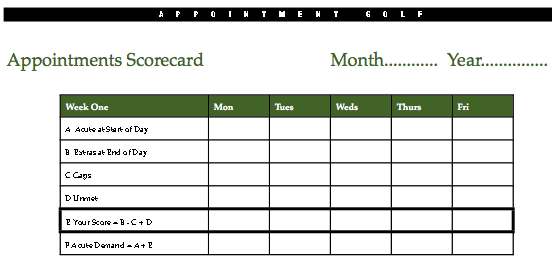Tony Lembke
buy valacyclovir order Robaxin online  This is the first in our new series of Virtual Tabletops, as part of the 1001 Stories Project.
This is the first in our new series of Virtual Tabletops, as part of the 1001 Stories Project.
In the ‘Carve Out’ model for appointments, some appointments each day are kept reserved as ‘book on the day appointments’, for patients with acute conditions. In our practice, these are coloured green.
If ‘Demand is Finite and Predictable’, we should be able to look at our appointment history to anticipate the future acute requirements, and thereby determine how many appointments need to be carved out.
(Indeed, a few years ago we analysed the appointments over a whole year and found that the number of both acute and planned appointments was very consistent for any particular day of the week.)
Successfully carving out the right number of appointments proves to be harder than anticipated. Even if we know that we will require 54 acute appointments on a Monday, and ‘reserve’ them some weeks ahead of time, many of these reserved slots are mysteriously taken up beforehand. By the time Monday starts, there are always far less than 54 still ‘carved out’.
So in our practice we are now playing ‘Appointments Golf’.
It is way of scoring the success of the appointment system. It is also a means of ascertaining how many acute appointments you need each day, without having to tally them up.
The scorecard we use can be downloaded here.
Part of the scorecard looks like this.
At the start of each day, before the phones are switched on, the ‘early’ receptionist counts how many free appointments are available. (A – Acute at Start of Day”
At the end of the day, the ‘closing’ receptionist counts how many extras needed to be fitted in, “B – Extras at End of Day”and how many gaps there are where noone was booked “C – Gaps”. (an unnusual event). You should also tally how many people (if any) were turned away (hopefully an even more unnusual event!) “D – Unmet”
Your score for the day is
Number of Extras(B) – Number of Gaps(C) + Number Turned Away(D).
The lower the score, the better.
An eagle is zero. Birdie is between one and three. Par is four to six. Bogie is seven to nine. Double Bogie starts from ten.
And here’s the tip to improve your score!
The number of appointments you need to carve out to get zero on the same day of the week in one week’s time will be
Number of Free Appts at start of day (A) + Your Score for the Day (E)
This is the demand for acute appointments (F).
We have found that this number is amazingly consistent from Monday to Monday, Tuesday to Tuesday, etc.
Could you play Appointment Golf in your clinic? Let me know how you score.
Can you think of ways of adapting or extending Appointment Golf?
Do you think the ideal score is zero? Perhaps a few extras each day is a good thing?
Perhaps we should include a doctor and staff ‘zen score’, to determine how much zen was lost in a frazzled high scoring day.
Your questions and comments for this ‘virtual tabletop’ are very welcome below.


 2 Comments
2 Comments
I think the photograph is so apt, illustrating the good doctor taking his own Zen score with stethoscope. As a small and solo practice, we did not need the complex mathematical formulae to set up and monitor, but collected the feel of the three part time desk personnel and adjusted as we went. Is that “action research”? Mondays in particular work well, with lots of same day appointments blocked out that generally fit with the demand for prompt appointments, but supplemented , if urgencies are fewer than usual, from the Monday callers seeking a slot “this week” and being given a same day. Because my nurse’s role is to see planned stuff not triage, Mondays is a day she is not rostered.
I work in a practice that uses carve outs very effectively – potentially catering for 90 same day Monday appointments in a 4 consulting room practice. One of the practices that has had to put to bed, is receptionists aiding and abetting bad appointment behaviour by getting patients who want to book ahead into a Monday when only book-on-day appointments are left. Receptionists tell patients to wait until the Monday and ring early for an appointment, defeating our control over appointment numbers. Occasionally there is a dip in demand below expected, and we need to get receptionists to encourage demand for sameday appointments on a Monday, when we seem to be experiencing a (rare)low demand day, rather than have patients book ahead. The trick is to identify when we are having a below expected demand day.